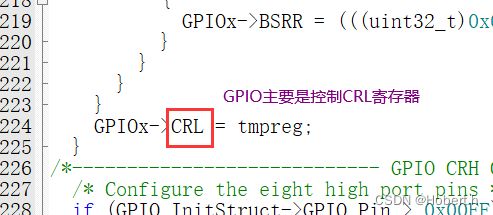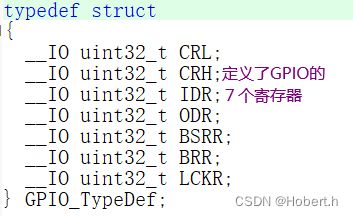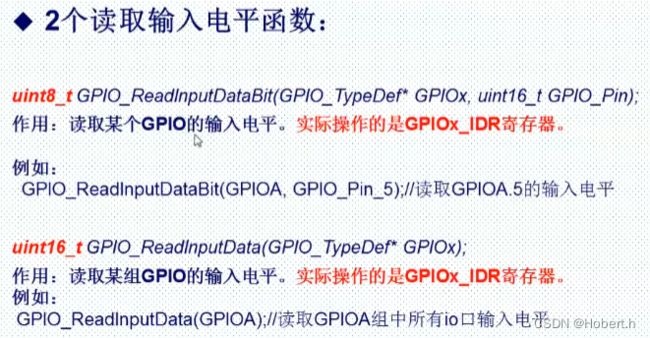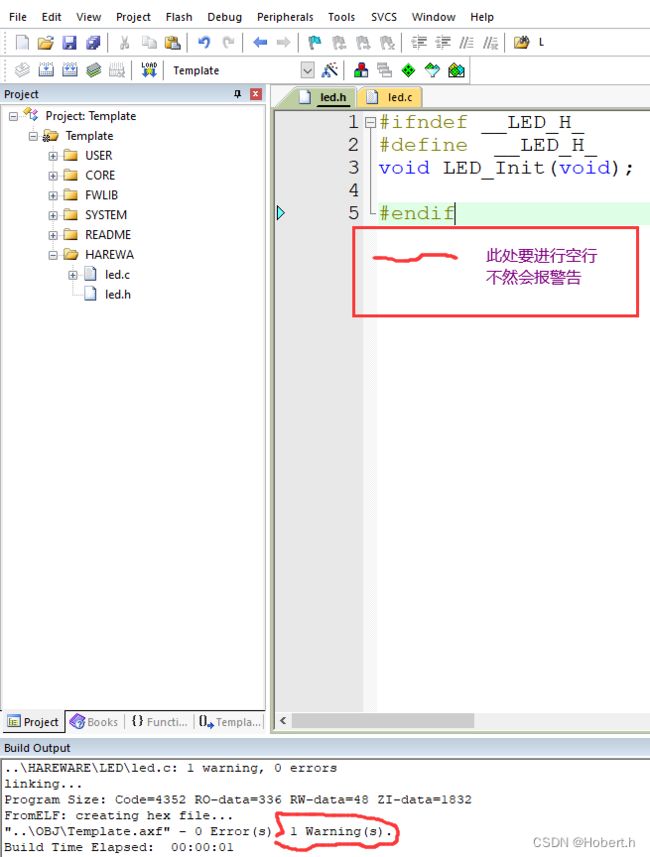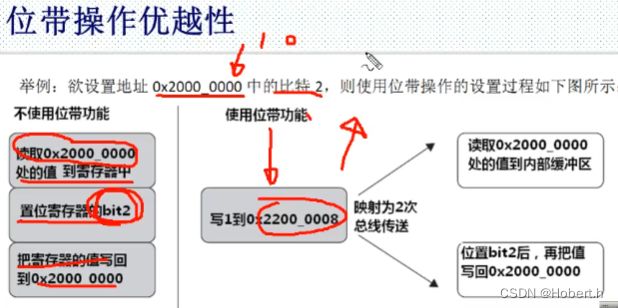STM正点mini-跑马灯
一.库函数版
1.硬件连接
GPIO的输出方式:推挽输出
IO口输出为高电平时,P-MOS置高,输出为1,LED对应引脚处为高电平,而二极管正0极被电阻拉高,两端都为高电平,LED灭
IO输出为低电平同理
2.GPIO库函数说明
操作IO口必须引入源文件和头文件
(1)初始化函数
1.简要
同时也控制BRR上下拉,最终控制ODR寄存器
![]()
2.初始化函数(详细说明)
第一个参数作用:选择是哪一个IO口(GPIOA~GPIOG)
GPIO_TypeDef* GPIOx对应的结构体类型
第二个参数作用:对参数进行初始化
GPIO_InitTypeDef* GPIO_InitStruct GPIO_Pin指定要配置的GPIO引脚。该参数可以是@ref GPIO_pins_define的任意值
GPIO_Pin指定要配置的GPIO引脚。该参数可以是@ref GPIO_pins_define的任意值
typedef struct
{
uint16_t GPIO_Pin; /*!< Specifies the GPIO pins to be configured.
This parameter can be any value of @ref GPIO_pins_define */
GPIOSpeed_TypeDef GPIO_Speed; /*!< Specifies the speed for the selected pins.
This parameter can be a value of @ref GPIOSpeed_TypeDef */
GPIOMode_TypeDef GPIO_Mode; /*!< Specifies the operating mode for the selected pins.
This parameter can be a value of @ref GPIOMode_TypeDef */
}GPIO_InitTypeDef;3.示例
进行宏定义
#define GPIO_Pin_0 ((uint16_t)0x0001) /*!< Pin 0 selected */
#define GPIO_Pin_1 ((uint16_t)0x0002) /*!< Pin 1 selected */
#define GPIO_Pin_2 ((uint16_t)0x0004) /*!< Pin 2 selected */
#define GPIO_Pin_3 ((uint16_t)0x0008) /*!< Pin 3 selected */
#define GPIO_Pin_4 ((uint16_t)0x0010) /*!< Pin 4 selected */
#define GPIO_Pin_5 ((uint16_t)0x0020) /*!< Pin 5 selected */
#define GPIO_Pin_6 ((uint16_t)0x0040) /*!< Pin 6 selected */
#define GPIO_Pin_7 ((uint16_t)0x0080) /*!< Pin 7 selected */
#define GPIO_Pin_8 ((uint16_t)0x0100) /*!< Pin 8 selected */
#define GPIO_Pin_9 ((uint16_t)0x0200) /*!< Pin 9 selected */
#define GPIO_Pin_10 ((uint16_t)0x0400) /*!< Pin 10 selected */
#define GPIO_Pin_11 ((uint16_t)0x0800) /*!< Pin 11 selected */
#define GPIO_Pin_12 ((uint16_t)0x1000) /*!< Pin 12 selected */
#define GPIO_Pin_13 ((uint16_t)0x2000) /*!< Pin 13 selected */
#define GPIO_Pin_14 ((uint16_t)0x4000) /*!< Pin 14 selected */
#define GPIO_Pin_15 ((uint16_t)0x8000) /*!< Pin 15 selected */
#define GPIO_Pin_All ((uint16_t)0xFFFF) /*!< All pins selected */
定义了枚举类型
typedef enum
{
GPIO_Speed_10MHz = 1,
GPIO_Speed_2MHz,
GPIO_Speed_50MHz
}GPIOSpeed_TypeDef;typedef enum
{ GPIO_Mode_AIN = 0x0,//模拟输入模式
GPIO_Mode_IN_FLOATING = 0x04,//浮空输入模式(复位后的状态)
GPIO_Mode_IPD = 0x28,//上拉/下拉输入模式
GPIO_Mode_IPU = 0x48,//保留
GPIO_Mode_Out_OD = 0x14,//通用开漏输出模式
GPIO_Mode_Out_PP = 0x10,//通用推挽输出模式
GPIO_Mode_AF_OD = 0x1C,//复用功能开漏输出模式
GPIO_Mode_AF_PP = 0x18//复用功能推挽输出模式
}GPIOMode_TypeDef;
(2)其余函数
问题:查看函数定义时报错
解决:
之后就可以成功转到定义了
------------------------------------------
3.代码实现
操作IO口之前,必须使能对应的时钟位
第一个参数
void RCC_APB2PeriphClockCmd(uint32_t RCC_APB2Periph, FunctionalState NewState)
{
/* Check the parameters */
assert_param(IS_RCC_APB2_PERIPH(RCC_APB2Periph));
assert_param(IS_FUNCTIONAL_STATE(NewState));
if (NewState != DISABLE)
{
RCC->APB2ENR |= RCC_APB2Periph;
}
else
{
RCC->APB2ENR &= ~RCC_APB2Periph;
}
}第二个参数
#define IS_FUNCTIONAL_STATE(STATE) (((STATE) == DISABLE(不使能)) || ((STATE) == ENABLE(使能)))
(1)创建HAREWARE文件,led.c,led.h
注:为避免重复调用头文件,通过预编译的方式,判断是否已经定义了一个唯一的标识符(所以这个标识符的命名是不重要的)
头文件要对MDK添加路径
注:
(2)led文件编写
h
#ifndef __LED_H_
#define __LED_H_
void LED_Init(void);
#endif
c
//#include "led.h"
#include "stm32f10x.h"
void LED_Init(void)
{
GPIO_InitTypeDef GPIO_InitStructure;
RCC_APB2PeriphClockCmd(RCC_APB2Periph_GPIOA,ENABLE);//使能GPIOB时钟
RCC_APB2PeriphClockCmd(RCC_APB2Periph_GPIOD,ENABLE);//使能GPIOB时钟
GPIO_InitStructure.GPIO_Mode=GPIO_Mode_Out_PP;/*初始化PA_8*/
GPIO_InitStructure.GPIO_Pin=GPIO_Pin_8;
GPIO_InitStructure.GPIO_Speed=GPIO_Speed_50MHz;
GPIO_Init(GPIOA,&GPIO_InitStructure);
GPIO_SetBits(GPIOA,GPIO_Pin_8);//PA_8输出高电平
GPIO_InitStructure.GPIO_Mode=GPIO_Mode_Out_PP;/*初始化PD_2*/
GPIO_InitStructure.GPIO_Pin=GPIO_Pin_2;
GPIO_InitStructure.GPIO_Speed=GPIO_Speed_50MHz;
GPIO_Init(GPIOD,&GPIO_InitStructure);
GPIO_SetBits(GPIOD,GPIO_Pin_2);//PD_2输出高电平
}
(3)main文件编写
#include "stm32f10x.h"
#include "led.h"
#include "delay.h"
int main()
{
delay_init();
LED_Init();
while(1)
{
GPIO_SetBits(GPIOA,GPIO_Pin_8);
GPIO_SetBits(GPIOD,GPIO_Pin_2);
delay_ms(300);
GPIO_ResetBits(GPIOA,GPIO_Pin_8);
GPIO_ResetBits(GPIOD,GPIO_Pin_2);
delay_ms(300);
}
}二.寄存器版
1.硬件连接
看库函数版,过程一样
2.代码实现
过程
GPIO都是挂载在APB2总线下
#define RCC ((RCC_TypeDef *) RCC_BASE)typedef struct
{
__IO uint32_t CR;
__IO uint32_t CFGR;
__IO uint32_t CIR;
__IO uint32_t APB2RSTR;
__IO uint32_t APB1RSTR;
__IO uint32_t AHBENR;
__IO uint32_t APB2ENR;
__IO uint32_t APB1ENR;
__IO uint32_t BDCR;
__IO uint32_t CSR;
#ifdef STM32F10X_CL
__IO uint32_t AHBRSTR;
__IO uint32_t CFGR2;
#endif /* STM32F10X_CL */
#if defined (STM32F10X_LD_VL) || defined (STM32F10X_MD_VL) || defined (STM32F10X_HD_VL)
uint32_t RESERVED0;
__IO uint32_t CFGR2;
#endif /* STM32F10X_LD_VL || STM32F10X_MD_VL || STM32F10X_HD_VL */
} RCC_TypeDef;注: 要写成int main()
(1)led.c编写
#include "stm32f10x.h"
void LED_Init(void)
{
RCC->APB2ENR|=(1<<2);//使能A/*使能时钟*/
RCC->APB2ENR|=(1<<5);//使能D
GPIOA->CRH|=0x00000003;/*设置推挽输出模式*/
GPIOD->CRL|=0x00000300;
}
(2)main文件的编写
配置ODR寄存器
#include "stm32f10x.h"
#include "led.h"
#include "delay.h"
int main()
{
delay_init();
LED_Init();
delay_ms(100);
while(1)
{
GPIOA->ODR=1<<8;
GPIOD->ODR=1<<2;
delay_ms(500);
GPIOA->ODR=~(1<<8);
GPIOD->ODR=~(1<<2);
delay_ms(500);
}
}配置BRR与BSRR寄存器、
#include "stm32f10x.h"
#include "led.h"
#include "delay.h"
int main()
{
delay_init();
LED_Init();
delay_ms(100);
while(1)
{
GPIOA->BSRR=1<<8;
GPIOD->BSRR=1<<2;
delay_ms(500);
GPIOA->BRR=(1<<8);
GPIOD->BRR=(1<<2);
delay_ms(500);
}
}三.位操作
1.位操作基本原理
2.硬件连接
看库函数版,过程一样
3.代码实现
(1)led.c文件编写
下面的是库函数版,也可以写成寄存器版
//#include "led.h"
#include "stm32f10x.h"
void LED_Init(void)
{
GPIO_InitTypeDef GPIO_InitStructure;
RCC_APB2PeriphClockCmd(RCC_APB2Periph_GPIOA,ENABLE);//使能GPIOB时钟
RCC_APB2PeriphClockCmd(RCC_APB2Periph_GPIOD,ENABLE);//使能GPIOB时钟
GPIO_InitStructure.GPIO_Mode=GPIO_Mode_Out_PP;/*初始化PA_8*/
GPIO_InitStructure.GPIO_Pin=GPIO_Pin_8;
GPIO_InitStructure.GPIO_Speed=GPIO_Speed_50MHz;
GPIO_Init(GPIOA,&GPIO_InitStructure);
GPIO_SetBits(GPIOA,GPIO_Pin_8);//PA_8输出高电平
GPIO_InitStructure.GPIO_Mode=GPIO_Mode_Out_PP;/*初始化PD_2*/
GPIO_InitStructure.GPIO_Pin=GPIO_Pin_2;
GPIO_InitStructure.GPIO_Speed=GPIO_Speed_50MHz;
GPIO_Init(GPIOD,&GPIO_InitStructure);
GPIO_SetBits(GPIOD,GPIO_Pin_2);//PD_2输出高电平
}
(2)main文件编写
#include "stm32f10x.h"
#include "led.h"
#include "delay.h"
#include "sys.h"
int main()
{
LED_Init();
delay_init();
while(1)
{
PAout(8)=1;
PDout(2)=1;
delay_ms(500);
PAout(8)=0;
PDout(2)=0;
delay_ms(500);
}
}
注:
由于在delay.h文件中已经引用了sys.h所以可以不用在main文件声明sys.h










